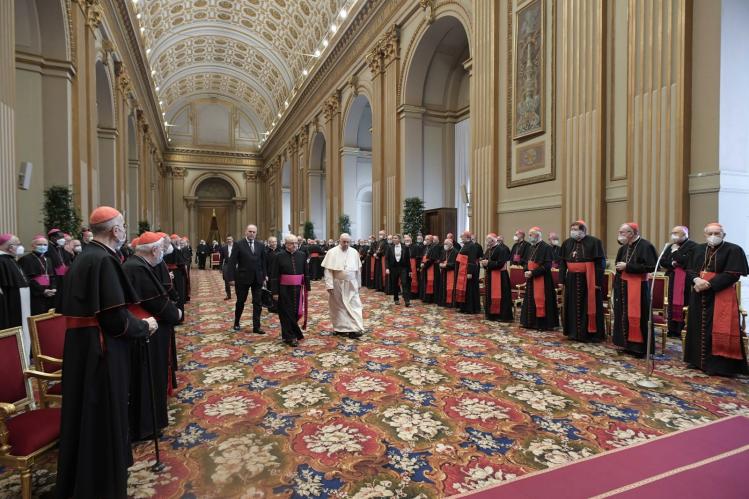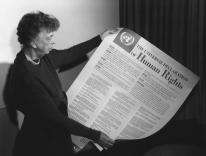
Many of us who are interested in reform of the Church’s central governing body have been misled: we were told that the new constitution for the Roman Curia would contain few surprises. We knew it was called Praedicate evangelium (“Preach the Gospel”), and that its unifying idea, taken from Evangelii gaudium, was making the Church suitable for the evangelization of today’s (secular) world rather than for its self-preservation in a vanished Christendom. We knew that Vatican bodies would no longer be divided into sheep and goats—lofty “congregations” with juridical clout and lowly “councils” producing unread reports—but would be level-pegged as “dicasteries,” from the Greek dikastērion, meaning law-court. We knew other things too: that women and lay people would rank high in some of the dicasteries, that the dicasteries would merge existing departments, and that the whole operation would be slimmed down. So what would be truly new in the ecclesial governance of the Eternal City? After all, the structural makeover has been in process on an experimental basis since 2015, visible to the naked eye. Praedicate, we assumed, would merely render de jure what was already de facto.
This turned out not to be true, but you wouldn’t have guessed this from the way the Vatican released Praedicate, dampening the drumrolls. The first new constitution of the Roman curia in more than thirty years landed in inboxes on a Saturday, without the usual notice, devoid of commentary, and only in Italian. The press conference two days later also seemed designed to keep corks in bottles: three Italian clerics read from a twenty-three-page commentary, which included a painstaking account of the way Praedicate had been drafted and redrafted over a period of nine years, in forty meetings of the pope’s council of cardinal advisors, then sent to cardinals and curia heads and on to every bishop’s conference, until it was finally ready in June 2020—only to be further niggled over by the soon-to-be-renamed Congregation of the Doctrine of the Faith and the Council for Legislative Texts. One thing was clear: the fifth apostolic constitution on the Roman curia in the Church’s history—after those of Sixtus V in 1588, Pius X in 1908, Paul VI in 1967, and John Paul II in 1988—is the fruit of an exhausting level of consultation, according to the ancient principle that “what affects all should be discussed by all.” Praedicate is built to last well into the next generation.
So what was new? The main news headline was that any baptized person can now head any dicastery, “depending on their competence, power of governance, and function,” as the fifth of the Principles and Criteria puts it. As this was reported (“Pope to allow…”), it was not, in fact, news: the Dicastery for Communication has been headed by a layman, Paolo Ruffini, for years, and a half-dozen women (mostly women religious and members of movements) have long occupied important posts in the Curia—women such as Francesca Di Giovanni, entrusted with the Holy See’s relations with the United Nations and other multilateral bodies. Yet there was something new here, something momentous, in the justification for that principle: “any of the faithful” can in principle head a dicastery because authority in the Curia is exercised vicariously, on the pope’s behalf, with power delegated directly from him.
Now it is true that John Paul II’s constitution also made clear that the Curia’s power is exercised vicariously, through power received from the pope. But Pastor bonus assumed that this power was delegated only to cardinals and bishops, because, well, since 1588 that had been the case. In the press conference to launch Praedicate, however, the Jesuit canonist Fr. Gianfranco Ghirlanda showed that the assumption should, if anything, be the opposite. If the power is the same (vicarious, delegated by the pope) whether exercised by a bishop, priest, religious, or layperson, then it settles a longstanding ecclesiological disputatio—namely, whether the power of governance is conferred by the sacrament of Orders. If it were, then lay people could not receive any office in the Church which involves the exercise of this power.
The Second Vatican Council did not want to settle the question and it was left open in the revised 1983 Code of Canon Law. But now, according to Ghirlanda, whose work has been on this very topic, Praedicate “confirms that the power of governance in the Church does not come from the sacrament of Orders, but from the canonical mission.” Hear that? Rome has spoken; the matter is settled. The fact that Ghirlanda was asked officially to present the constitution can only mean that this broader implication is what the pope intends, and it is law. Never has clericalism been dealt such a deadly, final blow.
In this and so many other ways, the understated presentation of Praedicate was at odds with its import, as the pope, who hates triumphalism, doubtless intended. For Praedicate distills into law the essence of the Francis reform, showing not just what the Roman Curia is for, but what the Church is for—and what shape and culture both must have if they are credibly to perform the Gospel they preach in the third millennium.
This, at last, is the reform “strongly wished for by most of the cardinals gathered in the pre-conclave general congregations” in 2013, as Praedicate recalls at the end of its preamble. The date of the constitution’s release—March 19, the ninth anniversary of Pope Francis’s inaugural Mass—is a reminder of those days, when cardinals in the wake of Benedict’s resignation stood up, one after another, to urge the next pope to turn a dysfunctional, inward-looking court of self-aggrandizing cronies into an effective, outward-looking organism of service to the whole Church. They wanted the Roman Curia, which had spent much of 2011 and 2012 deep in scandal, to be an inspiration and model, not an embarrassment; to facilitate rather than block relations between bishops and pope; to be a help in evangelizing, rather than a counter-witness.
Anyone who heard those pleas would see at once how Praedicate specifically addresses them. While St. John Paul II’s constitution, Pastor bonus, was called simply “Apostolic Constitution on the Roman Curia,” Francis’s Praedicate evangelium is called “Apostolic Constitution on the Roman Curia and its service to the Church in the world.” The most common complaint—after finances, which occupied the early years of Francis’s reform—had been that the Curia was a law unto itself, self-referential and haughty, wedging itself between the local Church and the papacy. The Curia famously treated bishops with contempt, as they found on their ad limina visits to Rome (so called because every few years a country’s bishops pay an official visit ad limina apostolorum, “to the threshold of the apostles,” touring the dicasteries and meeting the pope.) Many bishops say the attitude was encouraged by St. John Paul II’s 1988 Apostolos suos, which all but denied any standing to bishops’ conferences.
That has long since changed. Bishops are now amazed by their reception in Rome under Francis: curial officials are keen to hear and learn from them, and to assist them. In its preamble, Praedicate praises the key role of bishops’ conferences and regional collegial bodies, calls for a “healthy decentralization”—that is, autonomy regulated by the principle of communion—and says clearly that the Curia “does not place itself between the Pope and the bishops, but is at the full service of both.” Reflecting the hierarchical nature of the Church, which is both primatial and collegial (the bishops govern “with and under Peter”), the service of the Curia is organically tied to the bishops, as the pope is; and its remit is to build bonds of collegial governance and communion by acting as a nerve center for creative ideas and contacts between bishops’ conferences. Six articles of Praedicate (38–43) are dedicated to the ad limina visits, placing great importance on them, and stressing the role of the Curia in facilitating them.
Another complaint at those cardinals’ meetings in February and March 2013 was about the Vatican’s working culture: curial officials drawn from a narrow Italian pool too often turned out to be incompetent yet self-important obstructionists, prone to nepotism if not actual corruption, spiritually dried-out careerists and clericalists detached in every sense from the People of God. Expressing on paper years of Francis’s reforms, Praedicate’s second chapter says that curiali should be distinguished by their spiritual life, pastoral experience, sobriety of life, and love of the poor, as well as their competence and capacity for discernment, and that they should serve in a spirit of collaboration and co-responsibility.
They may be selected from among bishops, clergy, religious, and lay people alike. What matters is not their state in life, but their spirit of service and mission. They should be from different cultures to reflect the Church’s catholicity, and return to their dioceses or religious congregations after five years, which can be extended to a maximum of ten. According to their state of life, those who work in the Curia must attend to “the health of souls” in addition to their office tasks, be committed to regular personal and communal prayer, and carry out their work “with the joyful awareness of missionary disciples at the service of the entire People of God.” Indeed, the function of the Roman Curia is not, primarily, bureaucratic-administrative but pastoral: as Article 3 of the General Norms puts it, the Curia carries out “a pastoral service in support of the mission of the Roman Pontiff and the bishops in their respective responsibilities to the universal Church.”
There are many other important changes in Praedicate. The Pontifical Commission for the Protection of Minors, for example, now falls within the Dicastery for the Doctrine of the Faith, resolving an enervating identity crisis in which some commissioners tried to turn it into a vehicle for holding the pope accountable to victim groups. That meant it was kept at arm’s length by the Curia, weakening it. Now it will have real heft along with a degree of autonomy. On finances, there is now a healthy distance between the bodies that administer finances and those that hold them accountable—and sophisticated oversight mechanisms to detect wrongdoing.
Finally, the whole operation has been streamlined to prevent bloating and duplication. In addition to the Secretariat of State, four justice and six finance “bodies,” and three offices to run the pope’s household and liturgies, Praedicate reduces John Paul II’s twenty-one congregations and councils to sixteen juridically equal dicasteries with clearly distinct responsibilities, helping to prevent turf wars and allowing for greater “inter-dicasterial” collaboration and co-responsibility.
But the real punch of Praedicate—its evangelizing power—is in its vision of the Church, drawn from Evangelii gaudium and the Acts of the Apostles. The preamble reminds us that Christ’s mandate to preach the Gospel is the Church’s primary task, and that it does so by witnessing to the mercy it has received through acts and words of humble service: touching the suffering flesh of Christ in the poor and the sick. To enable this witness, the Church is called to a missionary conversion, to which the reform of the Roman Curia contributes by harmonizing the daily work of the Vatican with that broader call to evangelize that Francis believes God is now making to the Church.
Hence the new ranking of the dicasteries. Where St. John Paul II put the Congregation for the Doctrine of the Faith first, Francis puts the Dicastery for Evangelization first, with himself at its head. The faith dicastery comes second, followed by the new Dicastery for the Service of Charity, because the Gospel is preached in both words and actions. The other dicasteries follow in no particular order: for the Oriental Churches; for Divine Worship and the Discipline of the Sacraments; for the Causes of Saints; for Bishops; for the Clergy; for Institutes of Consecrated Life and Societies of Apostolic Life; for Laity, Family, and Life; for the Promotion of Christian Unity; for Interreligious Dialogue; for Culture and Education; for the Service of Integral Human Development for Legislative Texts; and for Communication.
The new thing here is a discreet but definite theological and ecclesiological shift. Pastor bonus focused almost every paragraph of its introduction on the Curia assisting the pope in his task of preserving the unity of faith and discipline. Communion in St. John Paul II’s constitution is identical with unity, described as “a precious treasure to be preserved, defended, protected and promoted.” This is the primary ministry, the telos, of the Supreme Pontiff, and therefore of the Curia. In Praedicate, by contrast, communion is not the object of the Curia’s efforts but rather the life made possible by Christ’s self-donation, to which the Curia witnesses by its internal culture. Communion “gives to the Church the face of synodality: a Church, that is, of mutual listening, in which everyone has something to learn: the faithful people, the college of bishops, the Bishop of Rome: each listening to the other, and all listening to the Holy Spirit…to hear what the Spirit is saying to the Churches.”
The difference matters. The Curia is not an instrument of power by which the pope unifies the Church through his efforts, but a witness to the communion of the life of the Church made possible by the Holy Spirit. It is a shift from confidence in human power to receptivity to the Spirit, away from a command-and-control vertical Church to one where authority is service. It is a synodal Church of mutual listening and reciprocity in which all participate, whatever their state of life, under the guidance of the Spirit, after the model of the early Church. Francis is explicit about this model: the purpose of the renewal of the Church, and therefore of the Roman Curia, is to “enable the community of believers to come as close as possible to the experience of missionary communion lived by the Apostles with the Lord while He was on earth, and, following Pentecost, in the first community of Jerusalem under the effect of the Holy Spirit.”
A synodal Roman Curia, marked by reciprocity and participation, fired by the Spirit for mission, dedicated to service, modeled on Acts? Wouldn’t that take a miracle? That thought may have occurred to Pope Francis, for the new constitution goes into effect on June 5, the Solemnity of Pentecost. Perhaps on that date we can allow ourselves to uncork some bottles and at last let the drums roll.
Please email comments to [email protected] and join the conversation on our Facebook page.
Previous Story
A Wonderful Complexity
Next Story
Letters | Lebanon, penance, secularization and the sacred


